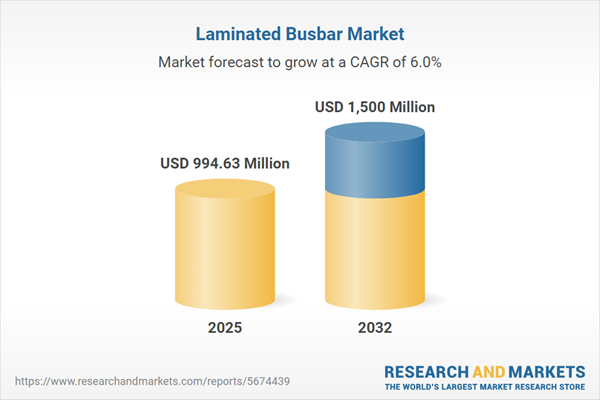Speak directly to the analyst to clarify any post sales queries you may have.
The laminated busbar market is evolving rapidly as new materials, electrification trends, and integration requirements drive adoption across multiple industries. Senior decision-makers seeking resilient power distribution solutions will find this market defined by strong innovation, changing regulatory demands, and complex supply dynamics.
Market Snapshot: Laminated Busbar Market Size and Growth
The Laminated Busbar Market grew from USD 941.62 million in 2024 to USD 994.63 million in 2025. It is expected to continue growing at a CAGR of 6.04%, reaching USD 1.50 billion by 2032.
Scope & Segmentation
This market analysis delivers granular insights into evolving segments, key technologies, and global opportunities:
- Material Types: Aluminum, Copper
- Form Factors: Bars, Solid rods, Strips, Tubes
- Insulation Materials: Epoxy Powder Coating, Heat-Resistant Fiber, Polyester Film
- Applications: Alternative Energy, Battery Systems, Power Distribution Systems, Transportation
- Industry Verticals: Aerospace & Defense, Automotive, Industrial, Power Electronics, Railways, Renewable Energy, Telecommunications
- Regional Coverage: Americas (United States, Canada, Mexico, Brazil, Argentina, Chile, Colombia, Peru), Europe, Middle East & Africa (United Kingdom, Germany, France, Russia, Italy, Spain, Netherlands, Sweden, Poland, Switzerland, United Arab Emirates, Saudi Arabia, Qatar, Turkey, Israel, South Africa, Nigeria, Egypt, Kenya), Asia-Pacific (China, India, Japan, Australia, South Korea, Indonesia, Thailand, Malaysia, Singapore, Taiwan)
- Companies Analyzed: ABB Ltd., Amphenol Corporation, EAE Elektrik A.Ş., Eaton Corporation PLC, Elektro Komponenten Vertrieb GmbH, Erie Industrial Products, LTD., EXXELIA Company by HEICO Corporation, Jans Electromate, KDM Steel, Kenmode, Inc., Mersen Corporate Services SAS, Methode Electronics, Inc., Molex, LLC by Koch, Inc., OEM Automatic Limited, Promet AG, Rittal GmbH & Co. KG by Friedhelm Loh Group, Rogers Corporation, Ryoden Kasei Co., Ltd. by Mitsubishi Electric Corporation, Segue Electronics, Inc., Sichuan Myway Technology Co.,Ltd., Sidhartha Metals Company, Storm Power Components, Sun.King Technology Group Limited, TE Connectivity Ltd., Xiamen Apollo Stamping Welding Technology CO., Ltd, Zhejiang RHI Electric Co.,Ltd .
Laminated Busbar Market: Key Takeaways
- The laminated busbar market is reshaped by electrification, materials advances, and the drive for system-level efficiency and reliability.
- Strategic material selection, such as choosing between aluminum and copper, directly impacts weight, cost, and conductivity—critical for applications in automotive and high-performance electronics.
- Insights show growing relevance of advanced insulation, including epoxy coatings and fiber reinforcements, supporting improved voltage withstand and thermal resilience.
- Industry needs are expanding from traditional power electronics into automotive, renewable energy, aerospace, and battery systems, calling for high-customization potential in form factors and material chemistries.
- Sustainability and recyclability concerns are influencing sourcing strategies, especially as supply constraints and regulatory scrutiny intensify across major regions.
- Competitive advantage increasingly depends on vertical integration, rapid prototyping, collaboration with OEMs, and ensuring certification alignment across sector-specific requirements.
Tariff Impact and Supply Chain Strategy
Evolving US tariff measures are prompting manufacturers and OEMs to redesign sourcing, diversify suppliers, and invest in regional production facilities. Shifts in trade policies affect procurement cycles and spark renewed focus on nearshoring, modular manufacturing, and supplier qualification, supporting more resilient laminated busbar supply chains.
Methodology & Data Sources
The report's findings leverage primary interviews with industry practitioners, complemented by technical literature analysis, product catalog review, and supply chain mapping. Cross-validation ensures actionable, reliable market intelligence for strategic planning. Proprietary data limitations are addressed using validated proxies and sensitivity checks for robust recommendations.
Why This Report Matters
- Provides actionable segmentation and technology insights to guide informed investments and supplier selection for decision-makers overseeing supply chain and product strategy.
- Delivers practical recommendations to optimize modular design, material sourcing, and regulatory compliance in response to evolving demand drivers and geography-specific challenges.
- Supports competitive positioning by covering technical differentiation, certification protocols, and evolving trends across major regional markets.
Conclusion
Laminated busbar technology is essential for compact, reliable power systems across industrial sectors. Targeted innovation, supply resilience, and focused qualification will enable organizations to realize sustained value in this dynamic market environment.
Additional Product Information:
- Purchase of this report includes 1 year online access with quarterly updates.
- This report can be updated on request. Please contact our Customer Experience team using the Ask a Question widget on our website.
Table of Contents
3. Executive Summary
4. Market Overview
7. Cumulative Impact of Artificial Intelligence 2025
Companies Mentioned
The companies profiled in this Laminated Busbar market report include:- ABB Ltd.
- Amphenol Corporation
- EAE Elektrik A.Ş.
- Eaton Corporation PLC
- Elektro Komponenten Vertrieb GmbH
- Erie Industrial Products, LTD.
- EXXELIA Company by HEICO Corporation
- Jans Electromate
- KDM Steel
- Kenmode, Inc.
- Mersen Corporate Services SAS
- Methode Electronics, Inc.
- Molex, LLC by Koch, Inc.
- OEM Automatic Limited
- Promet AG
- Rittal GmbH & Co. KG by Friedhelm Loh Group
- Rogers Corporation
- Ryoden Kasei Co., Ltd. by Mitsubishi Electric Corporation
- Segue Electronics, Inc.
- Sichuan Myway Technology Co.,Ltd.
- Sidhartha Metals Company
- Storm Power Components
- Sun.King Technology Group Limited
- TE Connectivity Ltd.
- Xiamen Apollo Stamping Welding Technology CO., Ltd
- Zhejiang RHI Electric Co.,Ltd .
Table Information
| Report Attribute | Details |
|---|---|
| No. of Pages | 188 |
| Published | November 2025 |
| Forecast Period | 2025 - 2032 |
| Estimated Market Value ( USD | $ 994.63 Million |
| Forecasted Market Value ( USD | $ 1500 Million |
| Compound Annual Growth Rate | 6.0% |
| Regions Covered | Global |
| No. of Companies Mentioned | 27 |









